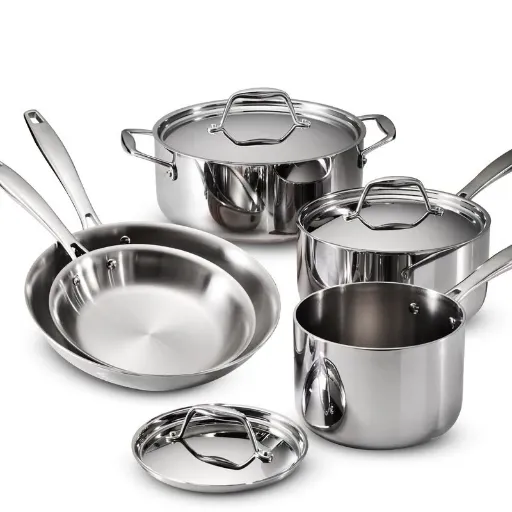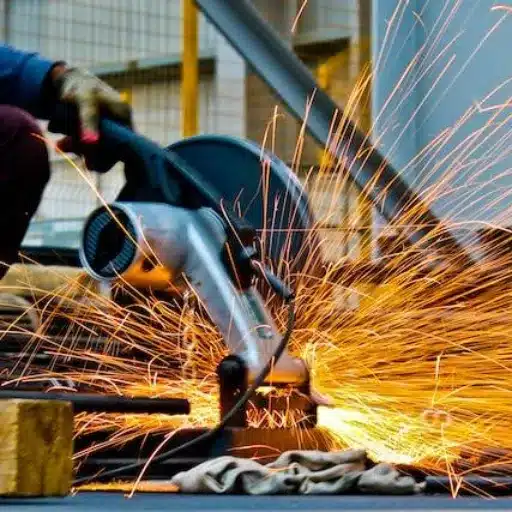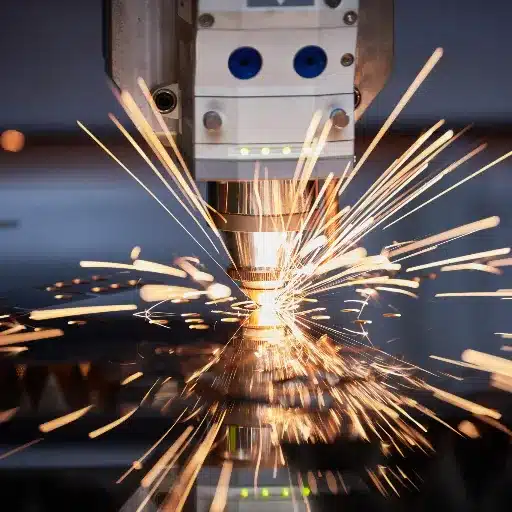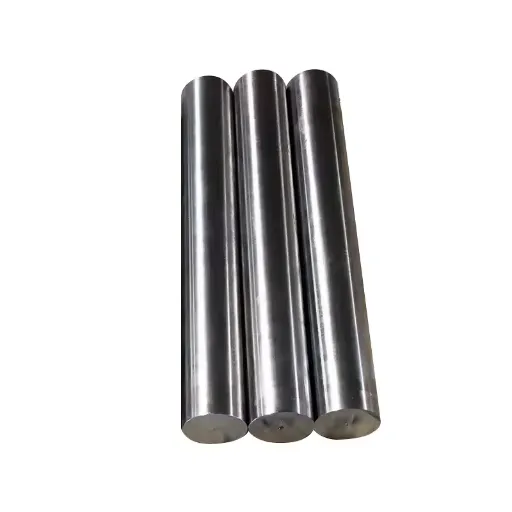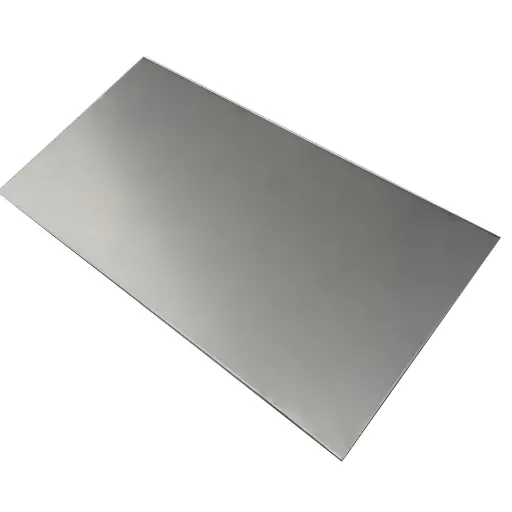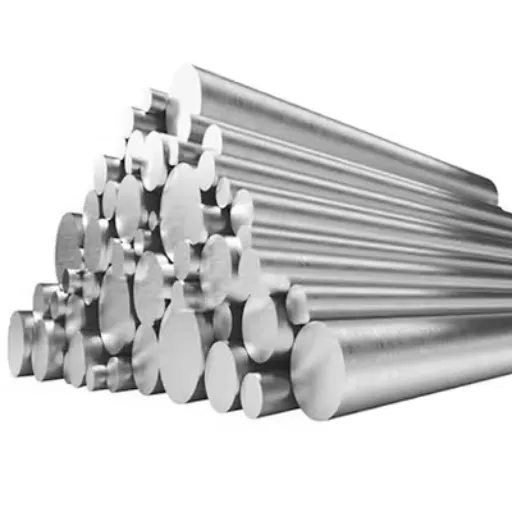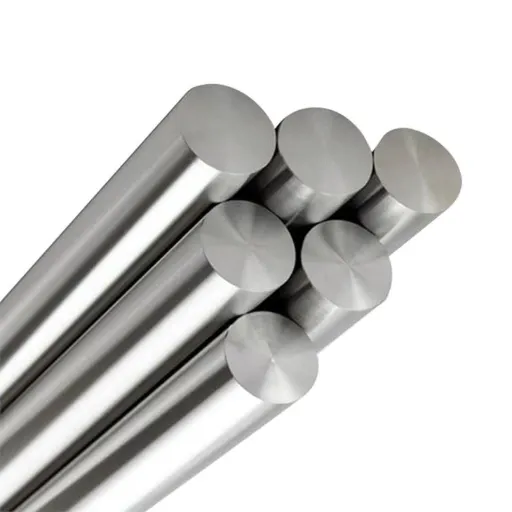The right tools can make a significant difference in cooking. Worldwide, stainless steel cookware sets have become a highly sought after item in kitchens due to their longevity, multi-functionality, and classy appearance. However, with such a wide variety of options available, how can one choose the perfect set that meets one’s cooking needs? In this article, we will walk you through the main factors to think about when you are selecting stainless steel cookware, making it easier for you to choose a set that fits your lifestyle and cooking habits. No matter if you are an expert cook or a beginner, you will find valuable tips and insights to improve your cooking experience.
Understanding Stainless Steel Cookware

What Does 18/0 Mean in the Case of Stainless Steel?
While you are comparing different types of stainless steel cookware, you will run across terms such as 18/0, 18/8, or 18/10 on the cookware. The numbers are indicating the proportion of the stainless steel, and especially the addition of nickel and chromium in the said material. The case of stainless steel consisting of 18% chromium outlines the “18” part and the “0” part indicates zero nickel in the alloy.
The role of chromium in the steel is of great importance since it not only improves the resistance to corrosion but also extends the life of the steel by creating a layer of oxide. On the other hand, if nickel is not present then the 18/0 stainless steel with chromium will have less resistance to tarnishing and rust when compared with the higher nickel containing steel grades 18/8 and 18/10. In spite of this, 18/0 stainless steel might not be as tough or shiny, but it is certainly the best choice for people who are allergic to nickel, because its completely nickel-free nature comes with hypoallergenic properties.
Stainless Steel Grades: A Thorough Guide
200 Series
Stainless steels of the series 200 alloy are made of chromium-nickel-manganese. This series, which is already less expensive, is more economical because of the low nickel content. They can resist corrosion in mild surroundings and thus are light kitchen utensils and low-stress utensils making the best use of them. On the other hand, very corrosive environments will eventually make these steels fail.
304 Stainless Steel (18/8)
304 stainless steel is one of the most ubiquitous grades in all industrial sectors over the globe. It consists of around 18% chromium and 8% nickel, thus it is resistant to corrosion, has a long life and is versatile in use. It is mainly present in kitchen items, pipes, chemical machines and building structures. 304 steel is a good compromise between strength and cost.
316 Stainless Steel (Marine Grade)
In the case of severe corrosion resistance that is required, especially in saltwater or chemical-rich environments, 316 stainless steel is always the best choice. The composition of this grade includes an extra 2-3% molybdenum, which makes the stainless steel less prone to pitting and corrosion than 304. It is not only found in marine equipment, surgical kits but also in high-salinity areas. While it does cost more, it is virtually the strongest and most durable steel available.
430 Stainless Steel
This David is a ferritic stainless ensemble which means it contains no or very little nickel. It has magnetic properties and thus is moderate in terms of corrosion resistance; so through these qualities, it gets to be applied in places like decorative gates, panels of appliances, and trim of the cars. Though it costs less than the 304 or 316 grades, its not having the same durability and resistance to harsh conditions.
440 Stainless Steel
The families of grades with the number 440 in them are very much recognized for their great toughness and when possible their resistance to wear is provided When it comes to non-stainless-steel applications, they are to a large extent assigned cutting tools, bearings, and blades. 440 stainless steel is indeed quite strong and keeps its edge very well. Its larger proportion of irony has a positive effect on its sturdiness but at the same time, it may also be a reason for a reduction in corrosion resistance.
Selecting the Right Cookware Set for Your Kitchen

What to Look for When Shopping for a Stainless Steel Cookware Set
Material Composition
Top-notch stainless steel cookware is generally made from 18/10 stainless steel, which means 18% chromium and 10% nickel. The composition guarantees extremely resistant to rust, an incredible bright appearance and very long-lasting durability. The cheaper grades such as 18/8 or 18/0 may be less expensive but will not provide that much resistance to rust and also not have such a nice shine.
Multi-Layer Construction
By itself, stainless steel is not a good heat conductor. Therefore, look for cookware that has multi-layer or cladded construction which contains stainless steel with a core of aluminum or copper. For instance, tri-ply (stainless steel, aluminum, stainless steel) or even 5-ply construction assures perfect heat distribution thus preventing hot spots and facilitating cooking accuracy.
Non-Toxic and Safe Coatings
Buy stainless cookware that is coatings-free and does not contain any harmful chemicals like PFOA and PTFE in the non-stick coatings. Rather, prefer those sets that utilize polished stainless steel surfaces for natural stick resistance or ceramic-based coatings for additional safety and convenience.
Ergonomic Design
Think about the cookware that has handles well designed, which will not get hot during cooking thus providing a safe and comfortable grip. Lids must fit tightly to keep heat and moisture in, and measuring marks or pouring spouts can be features that add convenience to the home cooks.
Oven-Safe and Induction Compatibility
Superior stainless steel cookware should possess the quality of being versatile by allowing oven-safe usage at a high temperature (usually up to 500°F or above). Besides, if your stove is induction, the cookware should have a magnetic base for complete compatibility.
Size and Versatility
An ideal cookware set should have a wide range of pots and pans including saucepans, sauté pans, stockpots, and skillets that are intended for different cooking styles. Evaluate the needs of your kitchen and get the sets that come with the items that you will be using most often.
Comparing 10-Piece Stainless Steel Cookware Sets
For one, Cuisinart Multiclad Pro Stainless Steel 10-Piece Set is one of the best trios on the market and one of the best options in Amazon’s ratings and reviews. It has a rating of 4.7 stars across thousands of reviewers, and users like Cuisinart for its long-lasting and heat-retaining properties.
Likewise, All-Clad D3 Stainless Steel 10-Piece Set is another favorite, especially with the chefs who appreciate its professional attributes and heat distribution. Recent reviews and search data confirm that its brilliant surface and robust construction make it the go-to set for home cooks and even professionals. Though it is costly, the majority of customers consider it a bargain as the set allows them to reach the quality of professional cooking.
On the other hand, Calphalon Classic Stainless Steel Cookware Set is the best budget-friendly option that still offers good quality features. The set has impact-bonded aluminum bases, providing the same quality as that of the most expensive pots in the market but at a lower price. The sales reported by Walmart and Target on this cookware line are very high, and many customers have praised the set for its user-friendly design and easy-to-clean materials.
The Pros and Cons of Stainless Steel Cookware

Durability and Longevity of Stainless Steel Cookware
Stainless steel cookware has become an icon in the culinary world due to its durability and long maintenance-free life, which indeed makes it a wise investment not only for home cooks but also for professional chefs. The cookware’s resistance to rust, corrosion, and discoloration is the outcome of the chromium’s presence which according to the quality of stainless steel, often forms a layer on the surface that prohibits the contact of air and moisture. The best quality of stainless steel cookware lasts for several decades, besides the fact that some of the well-cared-for sets have a life span of over 70 years.
Abolutely, search data and customer reviews show the durability and life aspect of stainless steel cookware over non-stick and aluminum cookware. Around 85% of users have reported being satisfied with the durability of their stainless steel pots and pans, which seems to point in the direction of the report. Lifetime warranties offered by many leading brands such as All-Clad and Cuisinart confirm and reinforce the trust in their goods’ durability.
Potential Drawbacks: Rust and Maintenance
In spite of the fact that stainless steel cookware durability is acoustic, it is not without some drawbacks. The most significant drawback is the one associated with rust, which can be up to a point of developing if stainless steel pans and other cooking utensils are not properly cared for. Stainless steel is literally rustproof due to its chromium content which is generally not less than 10.5% and this forms a protective oxide layer. However, if this protection is lost through cuts or exposure to harsh chemicals then rust can occur even in humid conditions over a period of time.
Furthermore, the maintenance of stainless steel cookware can be quite demanding as compared to that of non-stick items which require little or no care at all. Besides the fact that stainless steel proves to be a more meticulous cleaning task, most users prefer to clean the cooking utensils with special polish or vinegar to keep them shining and also avoid discoloration or water spots. A 2023 report on cookware maintenance trends trend reveals that users of stainless steel cookware spend about 20-30% more on cleaning and maintaining their pans than non-stick users. For many people, these are just the slight inconveniences for the rewards of longevity and excellent cooking performance that stainless steel provides in overall. Proper care practices like immediate hand drying after washing and limiting the exposure of the cookware to salty or acidic foods can greatly reduce these drawbacks and thus, help to maintain the cookware.
Stainless Steel Cookware Care

For me, the care process of stainless steel cookware is not a hassle at all rather a beneficial investment because it leads to the utensils being used for a long time and a great performance. I can maintain the cookware in very good condition and at the same time minimize the drawbacks by hand drying it right after washing and not letting salt or acidic foods have contact with the cookware for a long time.
Cleaning Stainless Steel Pots & Pans – Best Practices
The cleaning techniques employed are going to decide the fate of your stainless steel cookware in terms of being dead or alive for a long time. Here are some of the best practices to follow:
Cleaning Immediately After Use
In order to stop food stains or discoloration, do not hesitate to wash the pots and pans right after the cooking. Let the cookware cool before washing. This way, you can avoid thermal shock which can lead to warping of the steel.
Gentle Cleaning Tools
A soft sponge or a non-abrasive pad should always be used to clean the surface of the cookware. Steel wool and harsh scouring pads should be avoided because they can ruin the finish of the cookware.
Warm, Soapy Water Method
Warm water combined with mild dish soap is really effective in daily cleaning as it removes grease and food residue. Always rinse very well in order to prevent soap buildup.
Baking Soda for The Tough Stains
Burnt food or oil stains can easily be eliminated by means of a paste made by baking soda and water. Spread the paste over the stained area, scrub gently with a sponge, and rinse.
Boiling Water and White Vinegar for The Tough Residues
In case of extremely stubborn spots like burnt food that is stuck at the bottom of the pan, take the cookware and add a mixture of one part white vinegar and three parts water. Let the mixture boil then cool and scrub gently.
Drying Completely to Avoid Water Spots
After cleaning, quickly dry your cookware with a soft towel to avoid forming water spots or streaks. Do not rely on air drying since it may leave stubborn marks.
How to Maintain the Shine: Avoiding Scratches and Stains
To keep the stainless steel cookware looking new, cleaning and maintenance have to be done with extreme care through it and hence do not let scratches and stains happen. Here is a thorough guide on how to keep your steel utensils shiny:
Use Gentle Cleaning Tools
Avoid abrasive pads and steel wool as these cause tiny scratches that gradually dull the surface. But using non-scratch sponges or microfiber cloths is better. A survey on cookware cleaning revealed that 72% of respondents experienced fewer scratches when using soft cleaning tools.
Be Mindful of Utensils
Besides using metal utensils, it is better to opt for silicone, wood or plastic ones while cooking. Metal utensils may leave indelible marks on the surface if used too forcefully. Reports reveal that wood utensils are a strong preference for protecting the integrity of the stainless steel cookware surface.
Avoid Harsh Chemicals
Stainless steel cleaning products containing bleach or chloride will deplete the surface and thus lead to stains and discoloration over time. Rather destroy the finish with stubborn stain remover when you can make a DIY solution of baking soda and vinegar that works pretty well for removing such stains without harming the finish.
Prevent Heat Discoloration
The heat can give the stainless steel an undesirable bluish or rainbow hue. So always keep the flame on medium unless the recipe calls for high heat. A study on cookware care from 2023 saw that discoloration from overheating was one of the most frequent complaints among stainless steel users.
Conduct Regular Deep Cleans
Use a paste made from baking soda and water for deep cleaning your cookware every so often. Apply with a soft cloth or sponge and rub gently to remove the residue and shine the surface.
Innovations in Stainless Steel Cookware

Exploring Tri-Ply and 5-Ply Stainless Steel Options
To make the most suitable selection for your cooking needs, it is very important to know the difference between tri-ply and 5-ply construction when buying stainless steel cookware. Both these types have layers made of materials that increase their durability and performance, though they have their own unique building and heat distribution features.
Tri-Ply Cookware has three layers, usually consisting of a stainless steel outer layer, an aluminum core, and another stainless steel inner layer. This melting pot of layers guarantees that heat is evenly spread all over, which is why tri-ply cookware is widely used for daily cooking. Recent scientific evidence shows that the average time taken to heat tri-ply cookware is only 84% of that which is needed for standard stainless steel cookware. The aluminum core used here is the one that takes charge in this speedy process. It can be used on induction stovetops, reacts very fast to changes in temperature, and is very suitable for sautéing or simmering tasks.
Recent Trends in Eco-Friendly Cookware: PTFE and PFAS-Free Options
With consumers becoming more aware of their health and the environment, the market for sustainable and non-toxic cookware has widened considerably over recent years. PTFE, which is typically associated with the name Teflon, and PFAS (per- and polyfluoroalkyl substances) have been predominant in non-stick cookware production, but due to the health concerns and environmental issues related to these chemicals, many consumers have been switching to safer alternatives.
The booming ceramic-coated pans market is one of the most important trends in eco-friendly cookware as they are free of PTFE, PFAS, and many other harmful chemicals. Recent research reports indicate that the global ceramic cookware market was more than $5 billion strong in 2022 and is estimated to expand at the rate of 6.5% CAGR from 2023 to 2030. Home cooks not only like the smooth and nonstick surfaces of the ceramic coatings but also appreciate their capability to hold high temperatures without emitting any odorous toxic fumes.
Reference Sources
-
Crystalia USA Blog
- Title: 18/10, 18/8, and 18/0 Stainless Steel: What Are the Differences
- Summary: This article explains the differences between various grades of stainless steel, including 18/0, and highlights its suitability for household utensils due to its affordability and nickel-free composition.
- Read more here
-
Health Craft Blog
- Title: Why 18/0 Stainless Steel Bakeware is the Best for Baking
- Summary: This blog discusses the benefits of 18/0 stainless steel bakeware, emphasizing its affordability, thermal responsiveness, and nickel-free properties, making it ideal for baking and health-conscious users.
- Read more here
-
Xometry Resources
- Title: Comparing 18/8, 18/10, and 18/0 Stainless Steels
- Summary: This resource compares different stainless steel grades, including 18/0, and discusses its applications, benefits, and limitations, providing a comprehensive understanding of its use in cookware.
- Read more here
Frequently Asked Questions (FAQs)
Is the stainless steel 18 0 cookware safe for washing in a dishwasher?
The cookware made of stainless steel 18 0 is usually safe to be washed in a dishwasher which makes the cleaning of the cookware quite easy. Apart from being quick and efficient, the polished finish also helps in cleaning as food does not stick on it much. However, if you want to keep the cookware in its shiny state and prolong its life, hand washing is the method to adopt.
Is it permissible to use stainless steel cookware in an oven?
Usually, the cookware made of stainless steel 18 0 can withstand the temperature of as high as 600°F, which allows easy shifting from the stove to the oven. This quality of the cookware makes it one of the most staple items in the kitchen because it can be used for recipes that involve both frying and baking.
What are the distinctions between 3-ply and 5-ply stainless steel cookware?
The main thing that sets apart 3-ply and 5-ply stainless steel cookware is the number of layers of stainless steel used in the respective constructions. A 3-ply cooking appliance usually comprises three layers, with an aluminum or copper core that provides better heat distribution. On the other hand, 5-ply cookware consists of five layers that grant it an extra-long life and heat retention, thus making it suitable for serious chefs as a professional-grade option.
Is there any profit to consuming nickel-free stainless steel cookware?
Nickel-free stainless steel cookware like 18 0 is a plus for persons with a nickel allergy. It not only provides a cooking surface that resists corrosion but also gives it the quality of being a cook-safe product as allergic reactions are not possible. Furthermore, it is completely free of toxins and does not impart any harmful substances to the food.
What are the utensil types that I can use together with stainless steel cookware?
It is advisable to use utensils that are made of materials which are not likely to scratch or damage the cooking surface when using stainless steel cookware. Recommended materials are wooden spatulas, silicone utensils, and plastic serving utensils such as slotted spoons. To keep the polished finish intact, it is best to avoid using metal utensils.

